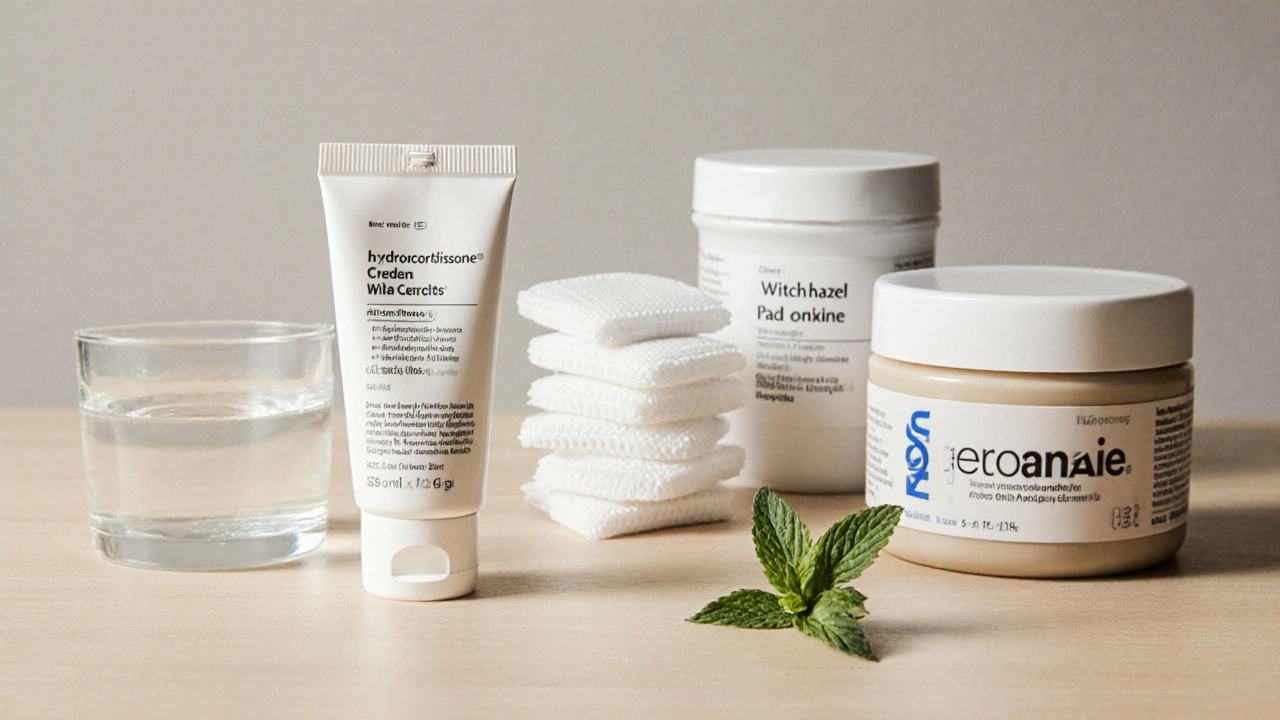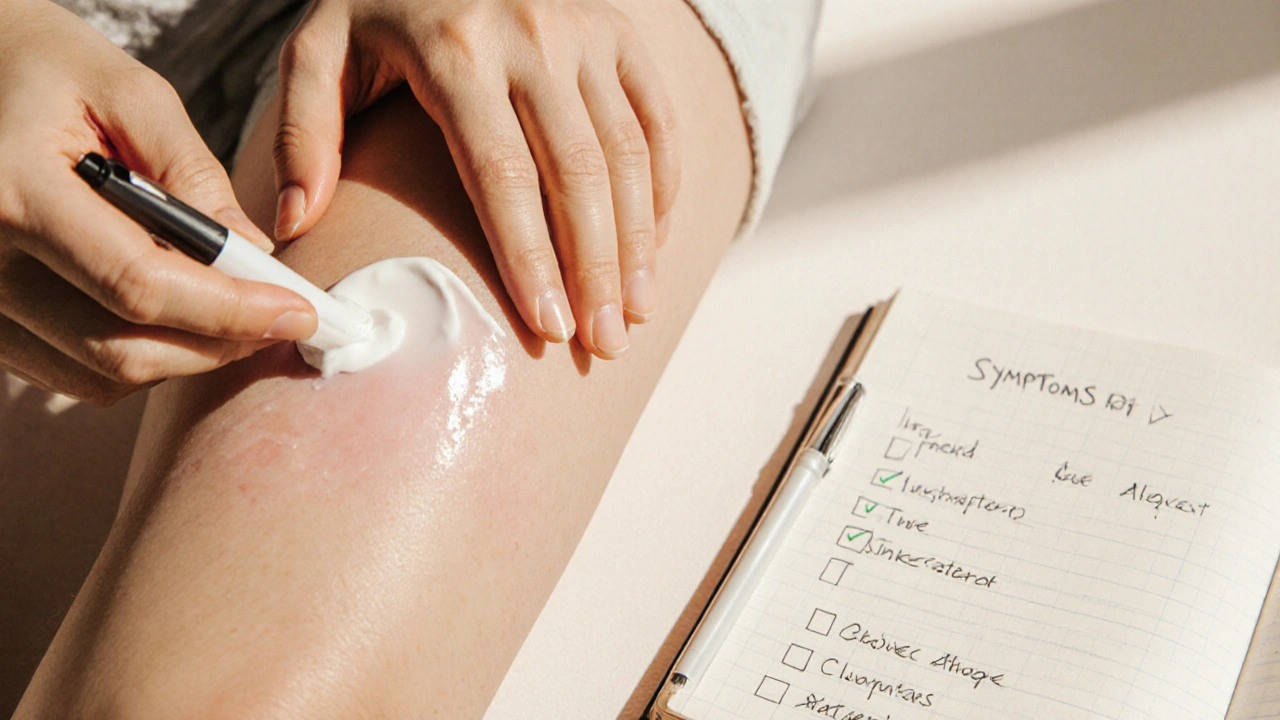Anal Itch Treatment Selector
This tool helps you select the most appropriate over-the-counter treatment based on your specific symptoms. Select your primary concern below:
Recommended Treatment Options
Option 1: Zinc Oxide Ointment
A barrier protection cream that shields skin from moisture and friction
Active Ingredients: Zinc oxide (10-20%)Best for: Moisture-related irritation, skin-to-skin friction
Option 2: Witch Hazel Pads
A plant-based astringent that tightens skin and calms irritation
Active Ingredients: Witch hazel extractBest for: Moisture-related irritation, gentle soothing
Option 3: Hydrocortisone Cream
Mild steroid that reduces inflammation and eases itching
Active Ingredients: Hydrocortisone (0.5-2%)Best for: Inflammation, mild hemorrhoids
Option 4: Lidocaine Cream
Temporary numbing agent that blocks pain signals
Active Ingredients: Lidocaine (2-5%)Best for: Sharp pain, spasms
Option 5: Anti-Hemorrhoid Ointment
Combination product for hemorrhoid relief and itching
Active Ingredients: Witch hazel, phenylephrine, petrolatumBest for: Hemorrhoid-related swelling and itching
Important Usage Guidelines
Use only as directed. Apply a thin layer. Never use hydrocortisone for more than two weeks without consulting a doctor. Avoid applying lidocaine near mucosal areas.
Quick Summary
- anal itching is usually caused by moisture, irritation or mild hemorrhoids and can often be managed with OTC products.
- Identify the main cause before picking a cream or ointment.
- Look for active ingredients such as hydrocortisone, witch hazel, zinc oxide, lidocaine or specialized hemorrhoid ointments.
- Check strength, formulation (cream vs ointment) and any extra ingredients that might aggravate sensitive skin.
- See a doctor if symptoms persist beyond a week, bleed heavily, or are accompanied by pain, fever or discharge.
What Is Anal Itching?
When dealing with anal itching is a common irritation around the anus caused by skin inflammation, moisture, food sensitivities, infections or mild hemorrhoids, the first instinct is often to reach for a quick fix. The area is delicate, so a product that’s too harsh can make things worse. Understanding why the itch started helps you pick a treatment that actually soothes instead of just masking the problem.
When to Use an OTC Remedy and When to See a Doctor
Most occasional itches clear up with good hygiene and a suitable OTC cream. However, red flags-such as bleeding, severe pain, a lump that doesn’t shrink, or an itch that lasts more than ten days-should prompt a medical visit. These signs may point to an infection, an anal fissure, or a more advanced hemorrhoidal issue that needs prescription‑strength care.

Key Ingredients in Over‑the‑Counter Products
OTC solutions typically revolve around a handful of proven actives. Below are the most common ones, each introduced with microdata for easy reference.
- Hydrocortisone cream is a mild steroid that reduces inflammation and eases itching. Strengths range from 0.5% to 2%.
- Witch hazel is a plant‑based astringent that tightens skin and calms irritation. It’s often found in pads or liquid wipes.
- Zinc oxide ointment is a barrier agent that protects skin from moisture and friction. It’s a staple for diaper rash and can help with anal irritation.
- Lidocaine cream is a numbing agent that temporarily blocks pain signals. Typical concentration is 2%-5%.
- Anti‑hemorrhoid ointment (e.g., Preparation H) is a blend of soothing agents and mild vasoconstrictors that relieve swelling and itching. Formulations often include witch hazel, phenylephrine and petroleum jelly.
How to Compare OTC Options
| Product Type | Active Ingredient(s) | Primary Action | Typical Strength | Best For | Potential Drawbacks |
|---|---|---|---|---|---|
| Hydrocortisone Cream | Hydrocortisone | Anti‑inflammatory | 0.5% - 2% | Inflammatory itch, mild hemorrhoids | May thin skin with long‑term use |
| Witch Hazel Pads | Witch hazel extract | Astringent, soothing | Pure extract (no %) | Moisture‑related irritation | Can be drying if over‑applied |
| Zinc Oxide Ointment | Zinc oxide | Barrier protection | 10% - 20% | Skin‑to‑skin friction, moisture | May feel greasy |
| Lidocaine Cream | Lidocaine | Topical anesthetic | 2% - 5% | Painful itch, spasms | Temporary numbness; avoid near mucosa |
| Anti‑Hemorrhoid Ointment | Witch hazel, phenylephrine, petrolatum | Swelling reduction, soothing | Varies per brand | Combined hemorrhoid and itch relief | Phenylephrine may cause mild burning |
Step‑by‑Step Guide to Picking the Right Product
- Pinpoint the likely cause - moisture, diet, hemorrhoids, or a skin condition.
- Match the cause to an active ingredient:
- Moisture‑related? Try witch hazel or zinc oxide.
- Inflammation? Hydrocortisone works well.
- Sharp pain? Lidocaine gives quick numbing.
- Hemorrhoidal swelling? Look for an anti‑hemorrhoid blend.
- Check the formulation - creams absorb faster, ointments stay longer; choose what feels comfortable for you.
- Read the label for any added fragrances, alcohol or preservatives that could irritate sensitive skin.
- Start with a small amount and use it for 3‑5 days. If itching eases, continue; if not, switch to a different active.
- Never apply more than the recommended frequency (usually 2‑3 times per day) to avoid over‑exposure.
Application Tips and Safety Precautions
Good hygiene sets the stage. Gently pat the area dry after washing; avoid rubbing, which can worsen irritation. Apply a thin layer of the chosen product using a clean fingertip or a disposable applicator. For creams, allow a minute for absorption before putting on underwear. If you’re using a barrier ointment like zinc oxide, reapply after each bowel movement.
Watch for signs of allergic reaction - redness, swelling, or a rash that spreads beyond the original spot. Discontinue use immediately and consider a hypoallergenic option or a prescription cream.

When to Seek Professional Help
If the itch persists beyond ten days despite proper OTC use, or if you notice bleeding, lumps, severe pain, or discharge, schedule a visit with a GP or colorectal specialist. Lab tests might be needed to rule out infections (bacterial, fungal, or parasitic) or inflammatory bowel disease.
Frequently Asked Questions
Frequently Asked Questions
Can I use hydrocortisone daily?
Short‑term use (up to two weeks) is generally safe for mild inflammation. Prolonged daily use can thin the skin, so switch to a milder option or see a doctor if you need longer relief.
Is witch hazel safe for sensitive skin?
Yes, witch hazel is alcohol‑free in most OTC pads and wipes, making it gentle. However, some formulations contain fragrance, so choose a plain, unscented version if you’re prone to reactions.
Do I need a prescription for lidocaine?
Low‑strength lidocaine (up to 5%) is available OTC for temporary pain relief. Higher concentrations require a prescription and should only be used under medical guidance.
Can a diet change help reduce anal itching?
Absolutely. Reducing spicy foods, caffeine, and alcohol can lower irritation. Adding fiber helps keep stools soft, decreasing friction that can trigger itching.
Is it okay to use more than one product at once?
Mixing products can increase the risk of irritation. If you want to combine a barrier (like zinc oxide) with an anti‑inflammatory (like hydrocortisone), apply the barrier first, let it absorb, then add the cream. When in doubt, stick to one product.
Next Steps
Start by cleaning the area gently, then pick an OTC product that matches your primary cause. Track how you feel for a few days - if the itch eases, you’ve likely found the right match. If not, try the next ingredient on the list or book an appointment with your doctor. Keeping a short symptom diary (what you ate, how often you applied the cream, any side effects) can speed up the consultation.


When you think about an itch, it’s not just a nuisance-it’s a signal from your body begging for balance 🌿. Remember that hygiene, diet, and stress all play a role, so the “right” cream is only part of the equation. If moisture is the culprit, a barrier like zinc oxide can be a lifesaver, but don’t forget to keep the area dry first. For inflammation, a modest dose of hydrocortisone works wonders, yet over‑use can backfire. Ultimately, listen to the itch, experiment responsibly, and you’ll find relief without drama.
Firstly, it must be emphatically noted that the original article, while comprehensive, suffers from several syntactic oversights which merit correction. The phrase “use only as directed” omits a necessary comma before the subordinate clause, thereby obscuring the intended pause. Moreover, the inconsistent use of hyphens in terms such as “over‑the‑counter” creates a visual dissonance that could mislead the attentive reader. One must also attend to the parallel structure in the list of active ingredients: “hydrocortisone, witch hazel, phenylephrine, petrolatum” should be uniformly presented without superfluous conjunctions. Finally, the recommendation to “apply a thin layer” would benefit from an explicit adverbial phrase, such as “gently apply a thin layer,” to convey the delicate nature of the site in question. In sum, while the medical content is sound, the linguistic precision requires refinement to match the professional standard expected of health‑care literature.
The philosophical underpinnings of itch management reveal a dialog between the body’s inherent wisdom and our pharmacological interventions. A simple barrier can often outshine a complex steroid, if one respects the principle of minimalism.
Indeed-maintain dry skin!!; use zinc oxide after each bowel movement; reapply if moisture returns; avoid scented wipes!!!
While many tout hydrocortisone as the panacea for any anal irritation, I find that the market’s hype often eclipses genuine efficacy. The notion that a 0.5 % cream will cure inflamed tissue within days ignores the complex microbiome that thrives in that niche. Moreover, layering multiple OTC products, as popular influencers suggest, can create a cocktail of irritants worse than the original problem. If you truly desire relief, consider the oft‑overlooked strategy of dietary fiber augmentation before slapping on a topical. Lastly, remember that “quick fixes” are seldom sustainable-long‑term hygiene habits trump any fleeting numbing sensation.
The author's emphasis on barrier creams is commendable, however the term “zinc oxde” contains a typographical error that could confuse readers. Accurate naming is essential for safe usage. Additionally, the dosage instructions should explicitly state “apply twice daily” to avoid over‑application.
i think the whole thing is pretty simple – keep it clean, pick the right cream, and dont overthink it. sometimes people get so caught up in the “which active ingredient” debate that they forget to just pat dry.
while some claim these creams are harmless the industry hides data about long term skin changes the real cure is to question why we accept this silent monopoly
Wow, the depth of this guide blew my mind! I was about to grab the first lidocaine tube I saw, but now I feel like I’ve unlocked a secret level of self‑care. Who knew that a simple switch from witch hazel to zinc oxide could feel like a revelation? This post turned my bathroom cabinet into a strategic command center. Seriously, thanks for the eye‑opening journey!
Yo, love the vibe! 🎉 That guide is like a fireworks show for the butt‑zone – bright, loud, and totally unforgettable. Got me pumped to try the zinc stuff and see if my rear can finally chill.
It’s amusing how often we chase the strongest solution, when a modest dose would suffice – a classic case of “more is better” fallacy. That said, the balanced approach you outline does deserve a nod for practicality. Just remember, a dash of sarcasm can keep the process from feeling like a chore. Keep the tone friendly and the instructions clear.
Honestly, the guide pretends to be neutral while subtly pushing certain brands – classic corporate sleight‑of‑hand. If you read between the lines, the subtle bias becomes evident. A more transparent comparison would serve the community better.
Everyone, let’s remember that comfort and safety come first – choose a product that respects your skin’s sensitivity. If you’re unsure, start with a mild witch hazel pad and observe any reaction. Encourage each other to share experiences, because collective wisdom reduces trial‑and‑error. Together we can turn an uncomfortable issue into a manageable routine.
Exactly! And don’t forget to keep the area dry after you shower – a quick pat with a soft towel does wonders.
Excellent summary; the table clarifies options succinctly. Please continue posting such well‑structured resources.
Thx for the table – it really helps! I wil definitely keep it handy next time I need to decide. Keep up the great work.
Choosing an over‑the‑counter treatment for anal itching is akin to navigating a nuanced landscape where biology, chemistry, and personal habits intersect. First, acknowledge that the skin around the anus is exceptionally thin and prone to irritation from moisture, friction, and microbial imbalance. Second, identify the primary driver of your discomfort, whether it is excess moisture, inflammatory redness, sharp pain, or hemorrhoidal swelling. Third, match that driver to a pharmacologic class: barrier agents for moisture, mild steroids for inflammation, local anesthetics for pain, and combination ointments for hemorrhoids. Fourth, scrutinize the concentration of active ingredients; a 0.5 % hydrocortisone is gentle enough for short‑term use, while concentrations above 2 % warrant medical supervision. Fifth, consider formulation preferences – cream absorbs quickly, whereas ointment provides a protective film that resists water. Sixth, assess any ancillary components such as fragrance, alcohol, or preservatives, which can exacerbate sensitivity. Seventh, apply the product sparingly, using a clean fingertip or applicator to avoid contamination. Eighth, observe a maximum frequency of two to three applications per day to prevent over‑exposure. Ninth, maintain meticulous hygiene by cleaning the area with mild soap and patting dry, never rubbing vigorously. Tenth, incorporate lifestyle modifications like increased dietary fiber, adequate hydration, and avoiding spicy or caffeinated foods that can aggravate the region. Eleventh, keep a simple diary noting product used, frequency, and symptom changes to detect patterns. Twelfth, if after a week of consistent, correct usage symptoms persist, escalated therapy or professional evaluation becomes necessary. Thirteenth, be vigilant for red‑flag signs such as bleeding, palpable lumps, severe pain, or discharge, which may indicate infection or advanced disease. Fourteenth, remember that OTC solutions are adjuncts, not substitutes for proper medical diagnosis when alarming signs appear. Finally, empower yourself with knowledge and patience, because the right combination of product, hygiene, and lifestyle adjustments can bring lasting relief without resorting to prescription medications.
Great breakdown! 🙌 Your step‑by‑step guide feels like a friendly roadmap, and the reminder to keep a symptom diary is pure gold. I’m going to try the zinc oxide barrier and track my progress – fingers crossed for a smoother ride. 🎯
Honestly, most of these creams are just hype.